2007 GMC SIERRA CLASSIC automatic transmission
[x] Cancel search: automatic transmissionPage 149 of 674
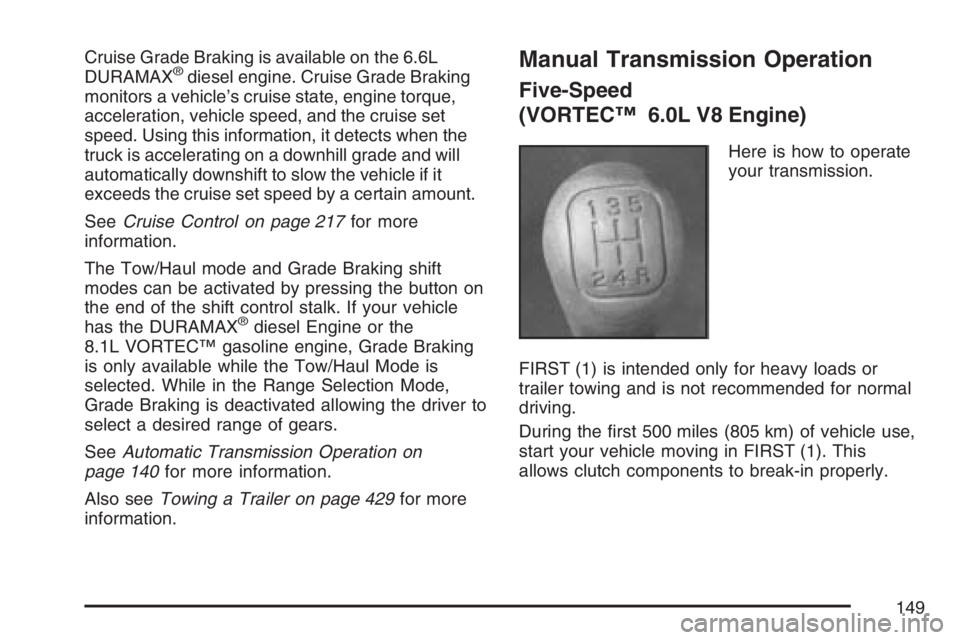
Cruise Grade Braking is available on the 6.6L
DURAMAX®diesel engine. Cruise Grade Braking
monitors a vehicle’s cruise state, engine torque,
acceleration, vehicle speed, and the cruise set
speed. Using this information, it detects when the
truck is accelerating on a downhill grade and will
automatically downshift to slow the vehicle if it
exceeds the cruise set speed by a certain amount.
SeeCruise Control on page 217for more
information.
The Tow/Haul mode and Grade Braking shift
modes can be activated by pressing the button on
the end of the shift control stalk. If your vehicle
has the DURAMAX
®diesel Engine or the
8.1L VORTEC™ gasoline engine, Grade Braking
is only available while the Tow/Haul Mode is
selected. While in the Range Selection Mode,
Grade Braking is deactivated allowing the driver to
select a desired range of gears.
SeeAutomatic Transmission Operation on
page 140for more information.
Also seeTowing a Trailer on page 429for more
information.
Manual Transmission Operation
Five-Speed
(VORTEC™ 6.0L V8 Engine)
Here is how to operate
your transmission.
FIRST (1) is intended only for heavy loads or
trailer towing and is not recommended for normal
driving.
During the �rst 500 miles (805 km) of vehicle use,
start your vehicle moving in FIRST (1). This
allows clutch components to break-in properly.
149
Page 153 of 674

When this light comes on, you can shift to the next
higher gear if weather, road and traffic conditions
allow. For the best fuel economy, accelerate slowly
and shift when the light comes on.
While you accelerate, it is normal for the light to
go on and off if you quickly change the position of
the accelerator.
If your vehicle has four-wheel drive and has a
manual transmission, disregard the shift light when
the transfer case is in Four-Wheel Low.
Ignore the shift light when you downshift.
Four-Wheel Drive
If your vehicle has four-wheel drive, you can send
your engine’s driving power to all four wheels
for extra traction. To get the most satisfaction out
of four-wheel drive, you must be familiar with
its operation. Read the part that follows before
using four-wheel drive. See the appropriate text for
the transfer case in your vehicle.
While driving on clean dry pavement and during
tight turns, you may experience a vibration in
the steering system.
Front Axle Locking Feature
The front axle locks and unlocks automatically
when you shift the transfer case. Some delay for
the axle to lock or unlock is normal.
Manual Transfer Case
The transfer case shift lever is located on the �oor
to the right of the driver. Use this lever to shift
into and out of four-wheel drive.
153
Page 157 of 674

Shifting In or Out of 4L (Four-Wheel
Drive Low)
Notice:Shifting the transfer case into 4L
while moving at speeds faster than 3 mph
(5 km/h) may cause premature wear to
the transfer case, and may cause the gears to
grind. To avoid causing premature wear,
and grinding the gears, do not shift the transfer
case into 4L while the vehicle is moving
faster than 3 mph (5 km/h).
Shifts into 4L can be made with the vehicle at a
stop, or while slowly rolling about 1 to 3 mph
(2 to 5 km/h).
Shift the automatic transmission into
NEUTRAL (N), or with a manual transmission,
press the clutch pedal, or shift into NEUTRAL.
Shift the transfer case shift lever in one
continuous motion into the 4L position.
When in 4L do not drive faster than 45 mph.
This will reduce wear and extend the life of
the transfer case.
Shifting In or Out of NEUTRAL
1. With the vehicle running and the engine at an
idle set the parking brake and apply the
regular brake.
2. Place the transmission into NEUTRAL (N).
Shift the transfer case in one continuous motion
into or out of the NEUTRAL position.
Automatic Transfer Case
The transfer case
buttons are located to
the left of the instrument
panel cluster.
Use these switches to shift into and out of
four-wheel drive.
157
Page 158 of 674

Recommended Transfer Case Settings
Driving
ConditionsTransfer Case Settings
2
mAUTO
4WD4m4nN
Normal YES
Variable YES
Severe YES
Extreme YES
Vehicle in
Tow*YES
*SeeRecreational Vehicle Towing on page 424for
further information.
You can choose among �ve driving settings:
Notice:Driving on clean, dry pavement in
Four-Wheel-Drive High or Four-Wheel-Drive
Low for an extended period of time may cause
premature wear on your vehicle’s powertrain.
Do not drive on clean, dry pavement in
Four-Wheel-Drive High or Four-Wheel-Drive
Low for extended periods of time.Indicator lights in the switches show the current
setting. The indicator lights will come on brie�y
when you turn on the ignition and the last chosen
setting will stay on. If the lights do not come
on, you should take your vehicle to your dealer for
service. An indicator light will �ash while shifting.
Fast �ashing means the conditions are not
being met to make the desired shift, typically the
vehicle is going too fast, the automatic
transmission is not in NEUTRAL, or the clutch
pedal is not fully pressed. Slow �ashing means the
shift is in progress. It will stay on when the shift
is completed. If for some reason the transfer case
cannot make a requested shift, it will return to
the last chosen setting.
AUTO 4WD (Automatic Four-Wheel Drive):This
setting is ideal for use when road surface
traction conditions are variable. When driving your
vehicle in AUTO 4WD, the front axle is engaged,
but the vehicle’s power is primarily sent to the rear
wheels. When the vehicle’s software determines
a need for more traction, the system will
transfer more power to the front wheels. Driving in
this mode results in slightly lower fuel economy
than Two-Wheel Drive High.
158
Page 160 of 674
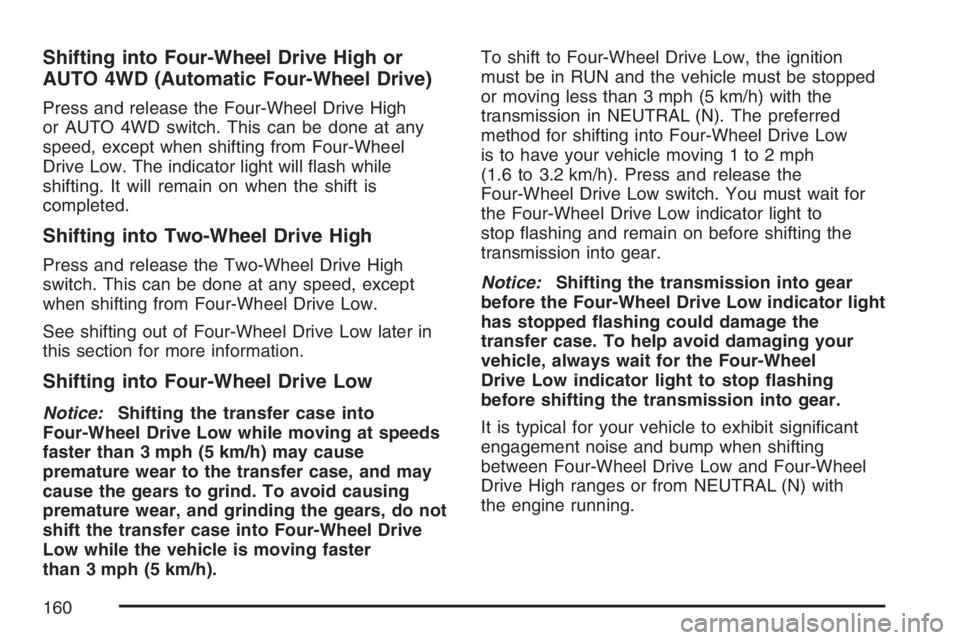
Shifting into Four-Wheel Drive High or
AUTO 4WD (Automatic Four-Wheel Drive)
Press and release the Four-Wheel Drive High
or AUTO 4WD switch. This can be done at any
speed, except when shifting from Four-Wheel
Drive Low. The indicator light will �ash while
shifting. It will remain on when the shift is
completed.
Shifting into Two-Wheel Drive High
Press and release the Two-Wheel Drive High
switch. This can be done at any speed, except
when shifting from Four-Wheel Drive Low.
See shifting out of Four-Wheel Drive Low later in
this section for more information.
Shifting into Four-Wheel Drive Low
Notice:Shifting the transfer case into
Four-Wheel Drive Low while moving at speeds
faster than 3 mph (5 km/h) may cause
premature wear to the transfer case, and may
cause the gears to grind. To avoid causing
premature wear, and grinding the gears, do not
shift the transfer case into Four-Wheel Drive
Low while the vehicle is moving faster
than 3 mph (5 km/h).To shift to Four-Wheel Drive Low, the ignition
must be in RUN and the vehicle must be stopped
or moving less than 3 mph (5 km/h) with the
transmission in NEUTRAL (N). The preferred
method for shifting into Four-Wheel Drive Low
is to have your vehicle moving 1 to 2 mph
(1.6 to 3.2 km/h). Press and release the
Four-Wheel Drive Low switch. You must wait for
the Four-Wheel Drive Low indicator light to
stop �ashing and remain on before shifting the
transmission into gear.
Notice:Shifting the transmission into gear
before the Four-Wheel Drive Low indicator light
has stopped �ashing could damage the
transfer case. To help avoid damaging your
vehicle, always wait for the Four-Wheel
Drive Low indicator light to stop �ashing
before shifting the transmission into gear.
It is typical for your vehicle to exhibit signi�cant
engagement noise and bump when shifting
between Four-Wheel Drive Low and Four-Wheel
Drive High ranges or from NEUTRAL (N) with
the engine running.
160
Page 164 of 674
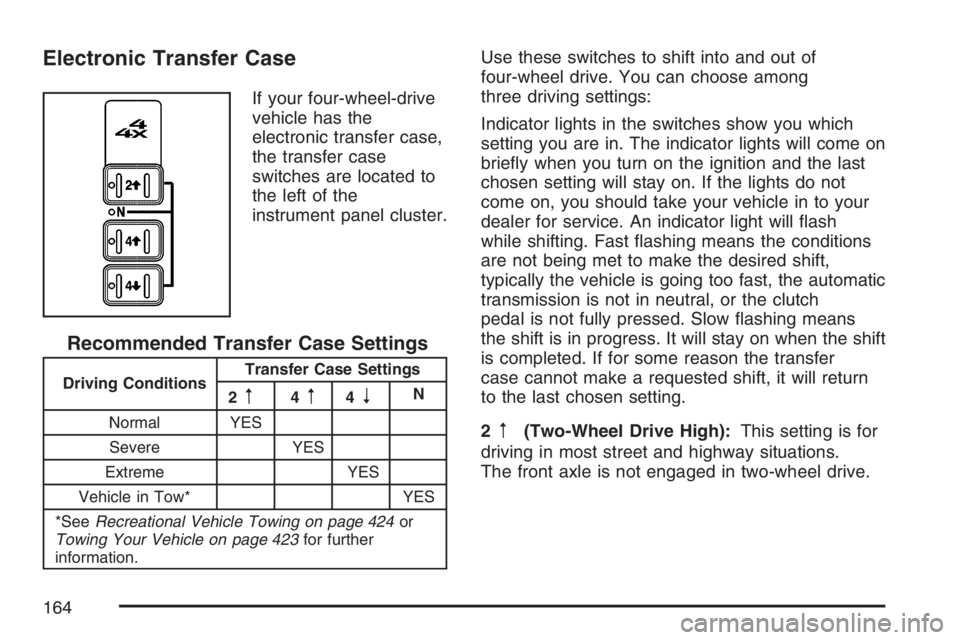
Electronic Transfer Case
If your four-wheel-drive
vehicle has the
electronic transfer case,
the transfer case
switches are located to
the left of the
instrument panel cluster.
Recommended Transfer Case Settings
Driving ConditionsTransfer Case Settings
2m4m4nN
Normal YES
Severe YES
Extreme YES
Vehicle in Tow* YES
*SeeRecreational Vehicle Towing on page 424or
Towing Your Vehicle on page 423for further
information.
Use these switches to shift into and out of
four-wheel drive. You can choose among
three driving settings:
Indicator lights in the switches show you which
setting you are in. The indicator lights will come on
brie�y when you turn on the ignition and the last
chosen setting will stay on. If the lights do not
come on, you should take your vehicle in to your
dealer for service. An indicator light will �ash
while shifting. Fast �ashing means the conditions
are not being met to make the desired shift,
typically the vehicle is going too fast, the automatic
transmission is not in neutral, or the clutch
pedal is not fully pressed. Slow �ashing means
the shift is in progress. It will stay on when the shift
is completed. If for some reason the transfer
case cannot make a requested shift, it will return
to the last chosen setting.
2
m(Two-Wheel Drive High):This setting is for
driving in most street and highway situations.
The front axle is not engaged in two-wheel drive.
164
Page 165 of 674
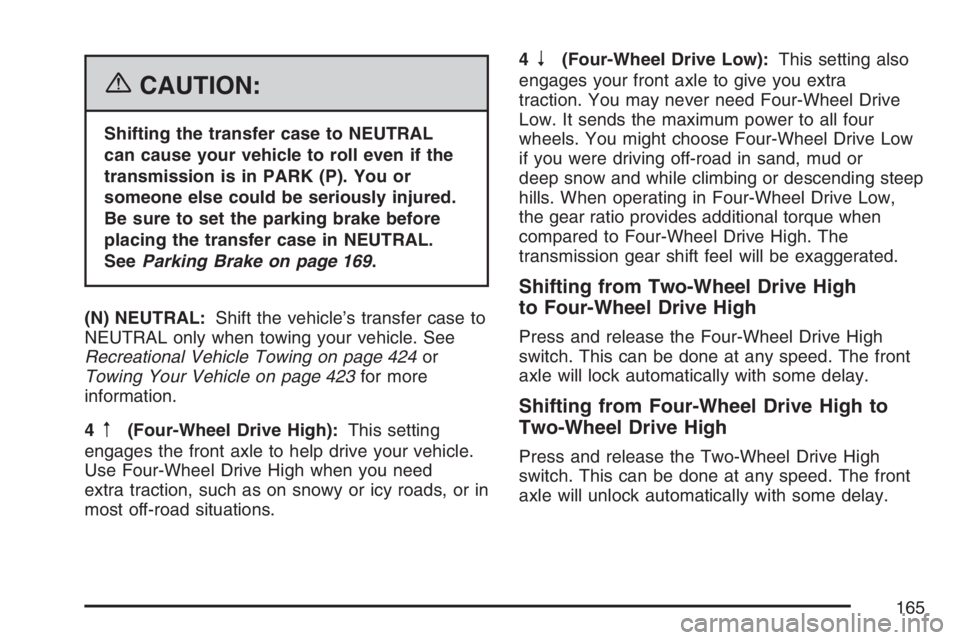
{CAUTION:
Shifting the transfer case to NEUTRAL
can cause your vehicle to roll even if the
transmission is in PARK (P). You or
someone else could be seriously injured.
Be sure to set the parking brake before
placing the transfer case in NEUTRAL.
SeeParking Brake on page 169.
(N) NEUTRAL:Shift the vehicle’s transfer case to
NEUTRAL only when towing your vehicle. See
Recreational Vehicle Towing on page 424or
Towing Your Vehicle on page 423for more
information.
4
m(Four-Wheel Drive High):This setting
engages the front axle to help drive your vehicle.
Use Four-Wheel Drive High when you need
extra traction, such as on snowy or icy roads, or in
most off-road situations.4
n(Four-Wheel Drive Low):This setting also
engages your front axle to give you extra
traction. You may never need Four-Wheel Drive
Low. It sends the maximum power to all four
wheels. You might choose Four-Wheel Drive Low
if you were driving off-road in sand, mud or
deep snow and while climbing or descending steep
hills. When operating in Four-Wheel Drive Low,
the gear ratio provides additional torque when
compared to Four-Wheel Drive High. The
transmission gear shift feel will be exaggerated.
Shifting from Two-Wheel Drive High
to Four-Wheel Drive High
Press and release the Four-Wheel Drive High
switch. This can be done at any speed. The front
axle will lock automatically with some delay.
Shifting from Four-Wheel Drive High to
Two-Wheel Drive High
Press and release the Two-Wheel Drive High
switch. This can be done at any speed. The front
axle will unlock automatically with some delay.
165
Page 166 of 674
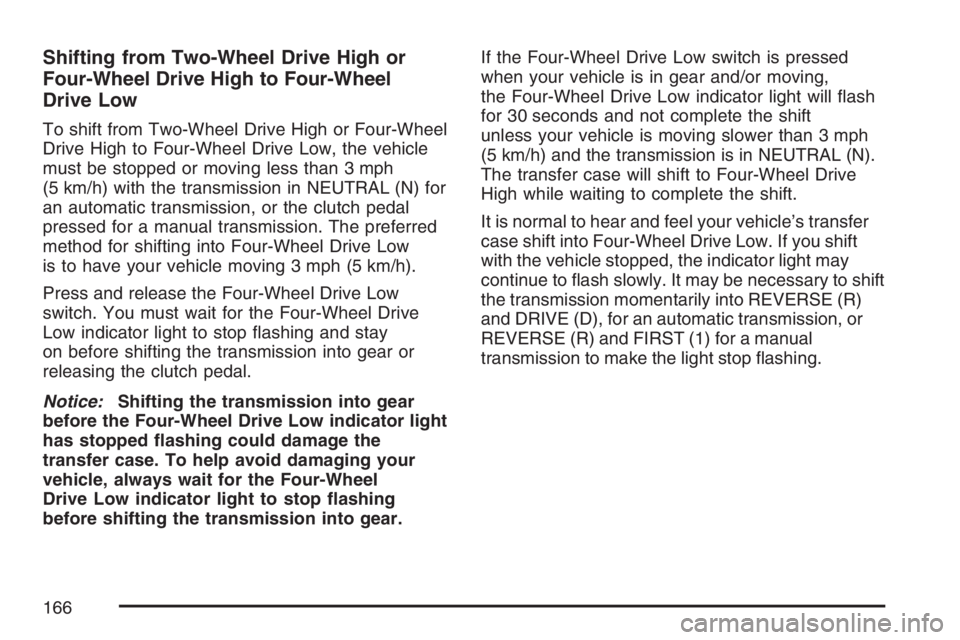
Shifting from Two-Wheel Drive High or
Four-Wheel Drive High to Four-Wheel
Drive Low
To shift from Two-Wheel Drive High or Four-Wheel
Drive High to Four-Wheel Drive Low, the vehicle
must be stopped or moving less than 3 mph
(5 km/h) with the transmission in NEUTRAL (N) for
an automatic transmission, or the clutch pedal
pressed for a manual transmission. The preferred
method for shifting into Four-Wheel Drive Low
is to have your vehicle moving 3 mph (5 km/h).
Press and release the Four-Wheel Drive Low
switch. You must wait for the Four-Wheel Drive
Low indicator light to stop �ashing and stay
on before shifting the transmission into gear or
releasing the clutch pedal.
Notice:Shifting the transmission into gear
before the Four-Wheel Drive Low indicator light
has stopped �ashing could damage the
transfer case. To help avoid damaging your
vehicle, always wait for the Four-Wheel
Drive Low indicator light to stop �ashing
before shifting the transmission into gear.If the Four-Wheel Drive Low switch is pressed
when your vehicle is in gear and/or moving,
the Four-Wheel Drive Low indicator light will �ash
for 30 seconds and not complete the shift
unless your vehicle is moving slower than 3 mph
(5 km/h) and the transmission is in NEUTRAL (N).
The transfer case will shift to Four-Wheel Drive
High while waiting to complete the shift.
It is normal to hear and feel your vehicle’s transfer
case shift into Four-Wheel Drive Low. If you shift
with the vehicle stopped, the indicator light may
continue to �ash slowly. It may be necessary to shift
the transmission momentarily into REVERSE (R)
and DRIVE (D), for an automatic transmission, or
REVERSE (R) and FIRST (1) for a manual
transmission to make the light stop �ashing.
166